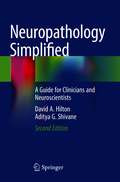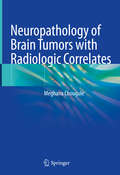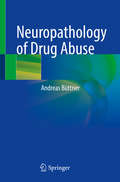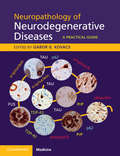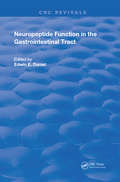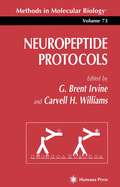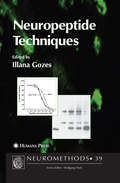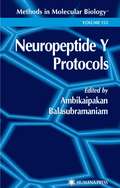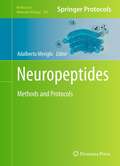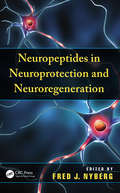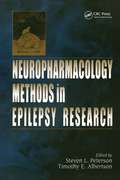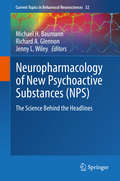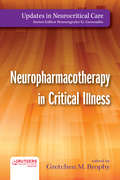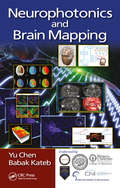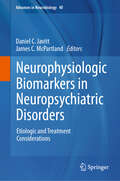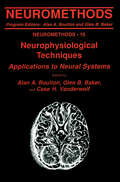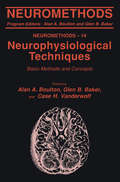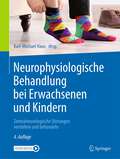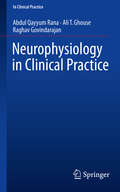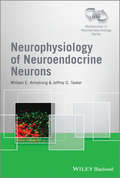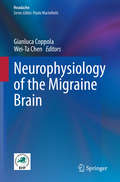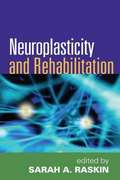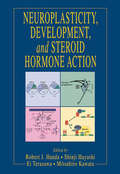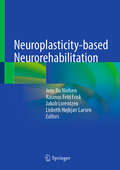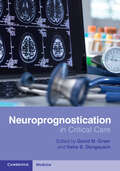- Table View
- List View
Neuropathology Simplified: A Guide for Clinicians and Neuroscientists
by David A. Hilton Aditya G. ShivaneThis updated second edition provides a practical and succinct overview of basic neuropathology. Key concepts and basic principles are covered and discussed with particular focus on recent advances, classification, and genetics. Practical points are included to detail how to best use the neuropathology service and interpret the results of pathological tests. Neuropathology Simplified aims to aid the development of multidisciplinary teams and help clinical trainees understand recent advances in neuropathological disorders. The book is also relevant to trainee and resident neurologists, pathologists, and neurosurgeons.
Neuropathology of Brain Tumors with Radiologic Correlates
by Meghana ChouguleThis highly illustrated book explores the pathological and radiological diagnosis of various brain tumors. Featuring nearly 500 high-quality colored images, it covers MR images, intra-operative squash cytology, histopathology and immunohistochemistry microphotographs of various brain and spine tumors, including differential diagnosis, as well as the molecular diagnosis and prognosis of each tumor. The book also presents case studies of typical and rare presentations, and introduces readers to a new procedure for intra-operative cytology: the modified fields stain, which stains the slide within 2 minutes, allowing quick, accurate reporting. This book uses concise text and a consistent point-wise format that makes reading and reviewing easy. The radiological and pathological correlates of brain and spine tumors serve as a ready-reference resource for residents, surgical and neuropathologists, neuroradiologists, neurosurgeons, neuro-oncologists and research scientists.
Neuropathology of Drug Abuse
by Andreas BüttnerThis book provides a comprehensive overview of the current state of knowledge concerning neuropathologies resulting from drug abuse. The first chapters offer readers detailed information on the neurobiological basics of drug abuse and the results of neuroimaging studies in drug abusers. The focus of the book is on neuropathological findings in drug abusers for the predominant substances, which include cannabis, opiates, cocaine, amphetamine, methamphetamine and a broad spectrum of designer drugs. These findings are supported by histological illustrations and discussed in connection with recent scientific publications. A chapter specifically addressing clinicians is also included, and highlights the implications for further therapy. The book is essential reading for neuropathologists, neurologists, neuroradiologists and psychiatrists, as well as other health professionals and scientists interested and engaged in the problem of drug abuse. Although a great deal of data has been derived from animal models and from human neuroimaging studies, little is known about the morphological effects of drug abuse on the human brain. In recent years, fundamental drug-induced effects on the cellular elements of the brain have been detected. These alterations might not only be the substrate of the neuroimaging data but might also have implications for clinical research and therapy. In addition, drug abuse may induce premature neurodegeneration.
Neuropathology of Neurodegenerative Diseases
by Gabor G. KovacsThis practical guide to the diagnosis of neurodegenerative diseases discusses modern molecular techniques, morphological classification, fundamentals of clinical symptomology, diagnostic pitfalls and immunostaining protocols. It is based on the proteinopathy concept of neurodegenerative disease, which has influenced classification and provides new strategies for therapy. Numerous high-quality images, including histopathology photomicrographs and neuroradiology scans, accompany the description of morphologic alterations and interpretation of immunoreactivities. Diagnostic methods and criteria are placed within recent developments in neuropathology, including the now widespread application of immunohistochemistry. To aid daily practice, the guide includes diagnostic algorithms and offers personal insights from experienced experts in the field. Special focus is given to the way brain tissue should be handled during diagnosis. This is a must-have reference for medical specialists and specialist medical trainees in the fields of pathology, neuropathology and neurology working with neuropathologic features of neurodegenerative diseases.
Neuropeptide Function in the Gastrointestinal Tract (Routledge Revivals)
by Edwin E. DanielFirst published in 1991: This book assimilates and evaluates the rapidly accumulating information regarding neuropeptides in the gut, their chemistry; genetic control; processing in enteric nerves; the projections of their nerves; their actions at the tissue, cell, and molecular levels; and their roles in controlling gut motility in health and disease. Neuropeptide Function in the Gastrointestinal Tract is directed to scientists in all disciplines who work with neuropeptides, as well as physiologists interested in the neural and smooth muscle actions of neuropeptides.
Neuropeptide Protocols
by G. Brent Irvine Carvell H. WilliamsLeading scientists offer an unprecedented suite of master protocols for analyzing neuropeptide structure and function using optimized classic methods and the latest state-of-the-art techniques. This comprehensive collection includes valuable techniques for extracting and purifying neuropeptides from biological sources, for their sequence determination by Edman degradation and PCR, and for the solid-phase synthesis and purification of peptides and peptide analogs. Also covered are physical techniques for the characterization of synthetic or natural peptides, methods for immunocytochemical sample preparation and visualization at both light and electron levels, and techniques for neuropeptide-receptor interaction. Chapters on molecular modeling, radioisotopic labeling, production of antisera, the measurement of efflux from brain to blood, and the assay and inhibition of neuropeptidases complete this indispensable collection of readily reproducible protocols.
Neuropeptide Techniques
by Illana GozesNeuropeptides exhibit multiple functions as hormones and regulators. As such, many techniques are required to understand the contribution and functions of neuropeptides in health and disease processes. Research in the neuropeptide field is aimed toward a better understanding of the physiology of the human body and toward the development of better diagnostics and therapeutics. This book will familiarize the audience with forefront techniques in the field.
Neuropeptide Y Protocols
by Ambikaipakan BalasubramaniamA strong cohort of established investigators from a variety of disciplines detail their best techniques for advancing NPY research. Among the many readily reproducible methods described are those for cloning, for the production of transgenic and knockout models, and for the use of antisense technology to define the receptors and the signal transduction pathways mediating NPY actions. A range of the major qualitative and quantitative techniques used to study tissue mRNA distribution are also included, as well as methods for radioligand binding. Highly practical and state-of-the-art, Neuropeptide Y Protocols constitutes a gold-standard collection of proven techniques for advancing today's understanding of this significant neuropeptide, as well as for developing the promising NPY-based therapeutics now emerging for many important disorders.
Neuropeptides
by Adalberto MerighiSince the early days, the field of neuropeptide biology has dramatically widened, and today the ultimate frontiers in neuropeptide research lie in the development of pharmacologically active compounds that are capable of crossing the blood-brain barrier to exert their biological role(s) in vivo and in the construction of genetic vectors to be employed in gene therapy. Neuropeptides: Methods and Protocols presents a readily reproducible collection of established and emerging techniques for neuropeptide research as contributed by expert researchers in the field. The detailed methods presented cover subjects such as immunocytochemical localization, biochemical characterization, functional analysis, development and production of genetic probes, and the design of neuropeptide derivatives for cellular neurobiology as well as the potential therapeutic applications. Written in the highly successful Methods in Molecular BiologyTM series format, chapters include introductions to their respective topics, lists of the necessary materials and reagents, step-by-step laboratory protocols, and key tips on troubleshooting and avoiding known pitfalls. Authoritative and easy to follow, Neuropeptides: Methods and Protocols is intended for a large audience of scientists, including histologists, biochemists, cellular and molecular biologists, and electrophysiologists that are currently active in the field or are willing to enter this exciting and still expanding area of neurobiology.
Neuropeptides in Neuroprotection and Neuroregeneration
by Fred J. NybergAlthough the genomic era is no longer in its infancy, the life sciences are still facing questions about the role of endogenous proteins and peptides in homeostasis and pathologies. Delving into one of the most current fields of interest in biology and medicine, Neuropeptides in Neuroprotection and Neuroregeneration describes the impact of neuropep
Neuropharmacology Methods in Epilepsy Research
by Timothy E. Albertson Steven L PetersonThere is an estimated 2.5 million epileptics in the US and perhaps some 40 million worldwide. As research has become increasingly molecular in scope, fewer scientists are trained in the US on basic, integrated epilepsy techniques. One frustration in neuroscience today is the application of state-of-the-art molecular biology techniques to inappropriate animal models of epilepsy - frequently resulting in inconclusive results. Epilepsy research will be increasingly undertaken by scientists well-trained in reductionist methodology, but who may be unfamiliar with integrated, whole-animal techniques. This situation appears even more difficult considering there has been no updated textbook on experimental models of epilepsy over the last twenty years - until now. Neuropharmacology Methods in Epilepsy Research describes fundamental methodologies and procedures in this field, representing the only detailed text concerning experimental models of epilepsy published in the last 20 years. This guide studies the reproduction of well-characterized and readily interpretable experimental models of epilepsy to which state-of-the-art molecular biology techniques can be applied. Each chapter features: Introduction - providing a brief background and historical account of the techniques and their use Methodology - describing equipment, solutions, species, electrodes as well as considering variations of techniques and stimulation parameters Interpretations - demonstrating the relevance of techniques to epilepsy as well as describing what exactly is being studied and how the data is appropriately applied to understanding epilepsy Topics include electroshock, chemoconvulsions, kindling, audiogenic seizures, focal seizures, and brain slice preparations. Discussions also include: Recently developed seizure models, including status epilepticus and massed trial simulations Influence of circadian and diurnal rhythms on convulsive activity Behavior al and cognitive deficits associated with anticonvulsant drug testing Technical approaches, i.e. slice models, microdialysis techniques, intracranial implant surgery, audiogenic seizure testing, kindling paradigms, and the rhythmic nature of seizures This unique text provides a thorough reference for the diverse methodologies within this area of neuropharmacological research - providing the basis for on-going cellular and molecular investigations as well as novel therapeutic approaches to the treatment of epilepsy.
Neuropharmacology of New Psychoactive Substances: The Science Behind the Headlines (Current Topics in Behavioral Neurosciences #32)
by Richard A. Glennon Michael H. Baumann Jenny L. WileyDesigner drugs, or new psychoactive substances (NPS), are synthetic chemicals that mimic the effects of classic drugs of abuse. There has been an alarming worldwide increase in the abuse of NPS in recent years. NPS are cheap, easy to obtain, and often legally available. In this volume, leading experts summarize the latest studies regarding the molecular mechanisms of action, behavioral effects, and adverse consequences of popular NPS. Specific chapters clarify the differences between various types of NPS, namely: stimulants, cannabinoids and hallucinogens. Thus, this volume broadens our understanding of NPS and provides insight into the rapidly evolving “new drug” phenomenon.
Neuropharmacotherapy in Critical Illness (Updates in Neurocritical Care)
by Gretchen Brophy Dr Teresa A Allison Dr Karen Berger Dr Kathleen A. Bledsoe Dr Jennifer Bushwitz Dr Amber Castle Dr Katleen Chester Dr Aaron M Cook Dr Emily Durr Dr Olabisi Falana Dr Jose Guzman Garcia Dr Haley Goodwin Gibbs Dr Kristy N Greene Dr Jimmi Hatton-Kolpek Dr Teresa Human Dr Lisa Kurczewski Dr John J Lewin III Dr Norah Liang Dr Kathryn A Morbitzer Dr Christopher Morrison Dr Ron Neyens Dr Viet Nguyen Dr Nicholas G Panos Dr Denise H Rhoney Dr A. Shaun Rowe Dr Ted Siindlinger Dr Eljim P TesoroThe field of research related to neurocritical care has grown significantly in recent years, and the clinical demands for current and dependable expertise has followed suit. It can be a challenge for the neurocritical practitioner to keep up with cutting-edge evidence-based research and best practices, especially regarding the role of pharmacotherapeutics. In the treatment of neurocritical disease states, pharmacotherapeutic strategies are increasingly relevant. Neuropharmacotherapy in Critical Illness is the first book that provides this information in a high-yield format for the busy healthcare provider. Edited and authored by leading experts in the field, this book provides practitioners with clinical pearls on neuropharmacology, dosing strategies, monitoring, adverse events, drug interactions, and evidence-based pharmacotherapy.
Neurophotonics and Brain Mapping
by Yu Chen Babak KatebUnderstanding how the brain works and developing effective therapeutics are important in advancing neuroscience and improving clinical patient care. Neurophotonics and Brain Mapping covers state-of-the-art research and development in optical technologies and applications for brain mapping and therapeutics. It provides a comprehensive overview of various methods developed using light, both microscopic and macroscopic techniques. Recent developments in minimally-invasive endoscopic imaging of deep brain structure and function, as well as light-based therapy are also reviewed.
Neurophysiologic Biomarkers in Neuropsychiatric Disorders: Etiologic and Treatment Considerations (Advances in Neurobiology #40)
by Daniel C. Javitt James C. McPartlandThis book reviews neurophysiological biomarkers in neuropsychiatric disorders from the viewpoint of the 21st Century Cures Act, which encourages the use of biomarkers for a variety of purposes during drug development. It covers both traditional etiologic uses of biomarkers and the more recent Biomarkers, EndpointS, and other Tools (BEST) classification scheme used by the FDA, which permits biomarkers for purposes of susceptibility, diagnosis, monitoring, prognosis, pharmacodynamics/response, and safety. The first section of the book describes potential uses of neurophysiologic biomarkers. Subsequent sections focus on a wide range of conditions, including schizophrenia, autism spectrum disorder, Parkinson’s disease, and depression, as well as cross-diagnostic and translational uses, including monkey and rodent analogs. The purpose of the book is to help clinicians understand how neurophysiological biomarkers may be used to understand and manage clinical conditions; to help researchers to understand how biomarkers may be used translationally to test specific theories; and to help pharma investigators to understand how biomarkers can be used to accelerate treatment development.
Neurophysiological Techniques, I: Applications to Neural Systems
by Alan A. Boulton Glen B. Baker Case H. VanderwolfThe latest information and methodologies for studying the activity of living nervous tissue, with special emphasis on electrophysiological techniques and their applications, ranging from ion channels to human behavior.
Neurophysiological Techniques, I: Basic Methods and Concepts
by Alan A. Boulton Glen B. Baker Case H. VanderwolfThe latest information and methodologies for studying the activity of living nervous tissue, with special emphasis on electrophysiological techniques and their applications, ranging from ion channels to human behavior.
Neurophysiologische Behandlung bei Erwachsenen und Kindern: Zentralneurologische Störungen verstehen und behandeln
by Sabine George Anke Hengelmolen-Greb Angela Harth Michael Ertl Reinhard Ott-Schindele Birgit RauchfußFunktionelles Alltagstraining ist bei zentralnervösen Schädigungen das A und O. Ergotherapeuten und Physiotherapeuten unterstützen hierbei den Patienten durch regelmäßiges Training und gezielte Behandlungseinheiten. In diesem Praxisbuch finden Sie die wesentlichen neurophysiologischen Grundlagen sowie die zugehörigen neuromuskulären, funktionellen Zusammenhänge, um Symptome bestmöglich behandeln zu können. In idealer Weise verknüpfen die erfahrenen Autoren und Therapeuten Praxis und Hintergrundwissen und zeigen bewährte Verfahren aus bekannten Therapiekonzepten wie Bobath, Affolter und Perfetti. Alltagsorientiert, aktuell und anregend: Das perfekte Nachschlagewerk für jeden Wissens- und Erfahrungsstand.Neu in der 4. Auflage: Videos veranschaulichen Fallbeispiele, sämtliche Kapitel komplett aktualisiert und erweitert.
Neurophysiology in Clinical Practice
by Abdul Qayyum Rana Ali T. Ghouse Raghav GovindarajanThis handbook provides a concise up to date review in interpreting electroencephalography and electromyography using simple illustrations. The book has been divided into two sections. Section 1 describes electroencephalography and Section 2 discusses electromyography and nerve conduction studies. Each chapter has been carefully drafted to provide the most up to date accurate information in an easy to understand format interspersed with diagrams and tables where needed. This book is aimed at trainees doing their neurophysiology rotation, general neurologists, general practitioners, advanced practice providers and neurophysiology technicians.
Neurophysiology of Neuroendocrine Neurons
by Jeffrey G. Tasker William E. ArmstrongNeurophysiology of Neuroendocrine Neurons provides researchers and students with not only an understanding of neuroendocrine cell electrophysiology, but also an appreciation of how this model system affords access to virtually all parts of the neuron for detailed study - something unique compared to most types of neuron in the brain. Chapters range from those describing the rich history and current state of in vivo recordings, highlighting the precise relationship between the patterns of action potential discharge in these neurons and hormone release, to in vitro approaches where neuroendocrine neurons can be precisely identified and their membrane properties, morphology, and synaptic responses, directly examined. * Written by a team of internationally renowned researchers, each chapter presents a succinct summary of the very latest developments in the field* Includes an evaluation of different experimental approaches, both in vivo and in vitro, and how the resulting data are interpreted* Both print and enhanced e-book versions are available* Illustrated in full colour throughoutThis is the first volume in a new Series 'Masterclass in Neuroendocrinology' , a co- publication between Wiley and the INF (International Neuroendocrine Federation) that aims to illustrate highest standards and encourage the use of the latest technologies in basic and clinical research and hopes to provide inspiration for further exploration into the exciting field of neuroendocrinology.
Neurophysiology of the Migraine Brain (Headache)
by Gianluca Coppola Wei-Ta ChenRoughly one in every five patients referred to a neurologist suffers from headaches; the majority have migraines. Although headache specialists understand migraine on a clinical basis, the pathophysiological changes that provoke and accompany the development of a migraine attack continue to elude us. Several decades have passed since the pioneering electroencephalographic study by Golla and Winter (1959), which underscored the role of abnormal rhythmic activities in migraine. Since then, there have been substantial advances in the field; a wealth of neurophysiological studies has enriched our understanding of the pathophysiological facets of the migraine pathology. Virtually every known technique of clinical electrophysiology has since been used to study the migraine brain and, more recently, new neurophysiological tools have been added to the arsenal. Nevertheless, applying the principles of peripheral and central neuromodulation offers a promising way to transfer the principles of synaptic plasticity to the patient’s bedside. This book belongs to the Headache Series endorsed by the European Headache Federation. Written by internationally recognized experts in their respective fields, it covers all aspects of clinical neurophysiological methods that represent significant advances in our understanding of the pathophysiology of migraine. It will offer a valuable toolkit for beginners, and a reference guide for experts.
Neuroplasticity and Rehabilitation
by Sarah RaskinBrain plasticity is the focus of a growing body of research with significant implications for neurorehabilitation. This state-of-the-art volume explores ways in which brain-injured individuals may be helped not only to compensate for their loss of cognitive abilities, but also possibly to restore those abilities. Expert contributors examine the extent to which damaged cortical regions can actually recover and resume previous functions, as well as how intact regions are recruited to take on tasks once mediated by the damaged region. Evidence-based rehabilitation approaches are reviewed for a range of impairments and clinical populations, including both children and adults.
Neuroplasticity, Development, and Steroid Hormone Action
by Robert J. Handa Shinji Hayashi Ei Terasawa Mitsuhiro KawataA compilation of cutting-edge research, Neuroplasticity, Development, and Steroid Hormone Action explores the effects of steroid hormones on brain development, function, and aging. The experimental approaches used by the authors ranges from molecular to behavioral and endocrine to neurobiological. It contains scientific photographs, line drawings, tables, color illustrations, and graphs, this interesting and timely text covers the neuroplastic effects of steroid hormones throughout the lifetime of various animal models, such as bees, fish, lizards, turtles, birds, mice, rats, and primates.
Neuroplasticity-based Neurorehabilitation
by Jens Bo Nielsen Rasmus Feld Frisk Jakob Lorentzen Lisbeth Højkjær LarsenKnowledge of how the brain works has increased dramatically within the past 15-20 years, introducing a powerful framework for developing general guidelines for practical neurorehabilitation. This textbook aims to give an overview of the current knowledge of neurobiology as a basis for deciding how best to help patients recover function after brain and spinal cord injuries. This book provides an overview of basic neurobiology and its practical application in neurorehabilitation. It explores neuroplasticity, beginning with its origins in neurodevelopmental plasticity and progressing to how scientific knowledge and technological advancements can enhance neuroplasticity and improve neurorehabilitation. Furthermore, a special focus is directed to various neurological disorders to illustrate condition-specific challenges and opportunities. The book benefits from the diverse perspectives of its contributors, who represent various fields. This diversity provides readers with a comprehensive understanding of neuroplasticity-based neurorehabilitation from a range of experts. This book is mainly intended for pregraduate physiotherapy, occupational therapy and neurorehabilitation students, but it can be of interest also to clinicians (doctors, therapists, nurses, psychologists) working in the field of neurorehabilitation, as part of postgraduate courses and studies.
Neuroprognostication in Critical Care
by David M. Greer Neha S. DangayachNeuroprognostication in patients with primary neurological diagnoses as well as in critically ill patients with concomitant neurological diagnoses is increasingly complex. With advances in critical care, the focus of the field is progressively moving from survivorship to improving patients' quality of life. This evidence-based resource provides an in-depth analysis of different aspects of prognostication in neurologically critically ill patients, covering how to gather the correct data and synthesize this information at the bedside. Delving into disease specific prognostication such as traumatic brain injury, acute ischemic stroke and delirium, guidance is provided for choosing management strategies based on overall perception of prognostication and shared decision making. Other topics covered include religious and legal issues, palliative care, chronic critical illness and new frontiers including machine learning and biomarkers usage. An online version of the book with expandable figures can be accessed on Cambridge Core, via the code printed inside the cover.
